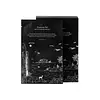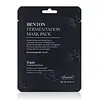What's inside
What's inside
 Key Ingredients
Key Ingredients

 Benefits
Benefits

 Concerns
Concerns

No concerns
 Ingredients Side-by-side
Ingredients Side-by-side

Water
Skin ConditioningButylene Glycol
HumectantGlycerin
HumectantNiacinamide
SmoothingHydroxyethyl Urea
HumectantCamellia Sinensis Leaf Extract
AntimicrobialSaccharomyces/Xylinum/Black Tea Ferment
Skin ConditioningAcetyl Hexapeptide-8
HumectantCopper Tripeptide-1
Skin ConditioningHydrolyzed Collagen
EmollientHydrolyzed Silk
HumectantHydrolyzed Keratin
HumectantVaccinium Angustifolium Fruit Extract
Skin ProtectingBroussonetia Kazinoki Callus Culture Extract
Skin ConditioningGlycine Max Seed Extract
Skin ConditioningButyrospermum Parkii Butter
Skin ConditioningSimmondsia Chinensis Seed Oil
EmollientPrunus Amygdalus Dulcis Oil
Skin ConditioningOlea Europaea Fruit Oil
MaskingHelianthus Annuus Seed Oil
EmollientSodium Hyaluronate
HumectantSodium Hyaluronate Crosspolymer
HumectantHydrolyzed Hyaluronic Acid
HumectantHyaluronic Acid
HumectantHydrolyzed Sodium Hyaluronate
Skin ConditioningHydrogenated Lecithin
EmulsifyingSqualane
EmollientCeramide NP
Skin ConditioningMacadamia Ternifolia Seed Oil
EmollientCetearyl Alcohol
EmollientBetula Platyphylla Japonica Juice
Skin ConditioningCoptis Japonica Root Extract
Skin ConditioningHouttuynia Cordata Extract
Skin ConditioningCentella Asiatica Extract
CleansingSodium Polyacryloyldimethyl Taurate
Emulsion StabilisingDiethoxyethyl Succinate
SolventHydroxyethylcellulose
Emulsion StabilisingCarbomer
Emulsion StabilisingArginine
MaskingCaramel
Cosmetic ColorantDextrin
AbsorbentAdenosine
Skin ConditioningDisodium EDTA
Propanediol
SolventHydroxyacetophenone
Antioxidant1,2-Hexanediol
Skin ConditioningDipotassium Glycyrrhizate
HumectantCaprylyl Glycol
EmollientPentylene Glycol
Skin ConditioningEthylhexylglycerin
Skin ConditioningWater, Butylene Glycol, Glycerin, Niacinamide, Hydroxyethyl Urea, Camellia Sinensis Leaf Extract, Saccharomyces/Xylinum/Black Tea Ferment, Acetyl Hexapeptide-8, Copper Tripeptide-1, Hydrolyzed Collagen, Hydrolyzed Silk, Hydrolyzed Keratin, Vaccinium Angustifolium Fruit Extract, Broussonetia Kazinoki Callus Culture Extract, Glycine Max Seed Extract, Butyrospermum Parkii Butter, Simmondsia Chinensis Seed Oil, Prunus Amygdalus Dulcis Oil, Olea Europaea Fruit Oil, Helianthus Annuus Seed Oil, Sodium Hyaluronate, Sodium Hyaluronate Crosspolymer, Hydrolyzed Hyaluronic Acid, Hyaluronic Acid, Hydrolyzed Sodium Hyaluronate, Hydrogenated Lecithin, Squalane, Ceramide NP, Macadamia Ternifolia Seed Oil, Cetearyl Alcohol, Betula Platyphylla Japonica Juice, Coptis Japonica Root Extract, Houttuynia Cordata Extract, Centella Asiatica Extract, Sodium Polyacryloyldimethyl Taurate, Diethoxyethyl Succinate, Hydroxyethylcellulose, Carbomer, Arginine, Caramel, Dextrin, Adenosine, Disodium EDTA, Propanediol, Hydroxyacetophenone, 1,2-Hexanediol, Dipotassium Glycyrrhizate, Caprylyl Glycol, Pentylene Glycol, Ethylhexylglycerin
Galactomyces Ferment Filtrate
HumectantWater
Skin ConditioningLactobacillus/Collagen Ferment Filtrate
HumectantGlycerin
HumectantPropanediol
SolventPentylene Glycol
Skin ConditioningButylene Glycol
HumectantBifida Ferment Lysate
Skin Conditioning1,2-Hexanediol
Skin ConditioningSodium Hyaluronate
HumectantCeramide NP
Skin ConditioningAloe Barbadensis Leaf Extract
EmollientAlthaea Rosea Root Extract
HumectantAcetyl Hexapeptide-8
HumectantCopper Tripeptide-1
Skin ConditioningBetaine
HumectantPanthenol
Skin ConditioningUsnea Barbata Extract
Zanthoxylum Piperitum Fruit Extract
Skin ConditioningPulsatilla Koreana Extract
Skin ConditioningHydroxyethylcellulose
Emulsion StabilisingAdenosine
Skin ConditioningCarbomer
Emulsion StabilisingHydrogenated Lecithin
EmulsifyingArginine
MaskingGalactomyces Ferment Filtrate, Water, Lactobacillus/Collagen Ferment Filtrate, Glycerin, Propanediol, Pentylene Glycol, Butylene Glycol, Bifida Ferment Lysate, 1,2-Hexanediol, Sodium Hyaluronate, Ceramide NP, Aloe Barbadensis Leaf Extract, Althaea Rosea Root Extract, Acetyl Hexapeptide-8, Copper Tripeptide-1, Betaine, Panthenol, Usnea Barbata Extract, Zanthoxylum Piperitum Fruit Extract, Pulsatilla Koreana Extract, Hydroxyethylcellulose, Adenosine, Carbomer, Hydrogenated Lecithin, Arginine
 Reviews
Reviews

Ingredients Explained
These ingredients are found in both products.
Ingredients higher up in an ingredient list are typically present in a larger amount.
1,2-Hexanediol is a synthetic liquid and another multi-functional powerhouse.
It is a:
- Humectant, drawing moisture into the skin
- Emollient, helping to soften skin
- Solvent, dispersing and stabilizing formulas
- Preservative booster, enhancing the antimicrobial activity of other preservatives
Acetyl Hexapeptide-8, commonly known as Argireline or Acetyl Hexapeptide-3, is a popular peptide in skincare. It’s often referred to as a “Botox-like” ingredient because it helps reduce muscle movement.
By relaxing these micro-movements, Argireline may help minimize the appearance of fine lines and wrinkles. That said, it’s not as powerful as Botox, and research on its long-term effectiveness is still limited.
Beyond smoothing, Argireline may also support collagen production. Collagen is the protein that helps keep your skin firm, bouncy, and well-hydrated by strengthening the skin barrier.
So while Argireline isn’t a miracle fix, it can be a helpful addition to a routine focused on both prevention and skin health.
Read more about other common types of peptides here:
Learn more about Acetyl Hexapeptide-8Adenosine is in every living organism. It is one of four components in nucleic acids that helps store our DNA.
Adenosine has many benefits when used. These benefits include hydrating the skin, smoothing skin, and reducing wrinkles. Once applied, adenosine increases collagen production. It also helps with improving firmness and tissue repair.
Studies have found adenosine may also help with wound healing.
In skincare products, Adenosine is usually derived from yeast.
Learn more about AdenosineArginine is an amino acid that is important for human development. Your body uses is it to produce hair keratin and skin collagen.
As a cosmetic ingredient, Arginine has antioxidant properties and can also help repair damaged skin. This ingredient is derived either synthetically or from animals.
Arginine isn't fungal acne safe when used in the presence of other lipids (fats, fatty acids, oils, esters, etc). Oils and fats occur naturally within the skin, so take caution when using Arginine if you're prone to fungal acne.
Learn more about ArginineButylene Glycol (or BG) is used within cosmetic products for a few different reasons:
Overall, Butylene Glycol is a safe and well-rounded ingredient that works well with other ingredients.
Though this ingredient works well with most skin types, some people with sensitive skin may experience a reaction such as allergic rashes, closed comedones, or itchiness.
Learn more about Butylene GlycolCarbomer is a polymer of acrylic acid. Its main role is to create a gel consistency.
A high amount of carbomer can cause pilling or balling up of products. Don't worry, most products contain 1% or less of carbomer.
Ceramide NP is a type of ceramide and formally known as ceramide 3.
Ceramides are intercellular lipids naturally found in our skin that bonds dead skin cells together to create a barrier. They are known for their ability to hold water and thus are a great ingredient for dry skin.
Ceramides are an important building block for our skin barrier. A stronger barrier helps the skin look more firm and hydrated. By bolstering the skin ceramides act as a barrier against irritating ingredients. This can help with inflammation as well.
If you would like to eat ceramides, sweet potatoes contain a small amount.
Read more about other common types of ceramides here:
Ceramide AP
Ceramide EOP
Copper Tripeptide-1 (GHK-Cu) is a skin repairing ingredient known for its ability to boost collagen, improve firmness, and support skin regeneration.
It is a complex made up of a naturally occurring peptide (glycine-histidine-lysine) and copper, an essential trace element.
While studying wound healing, researchers noticed GHK-Cu stimulated hair follicle enlargement and growth by keeping hair in its active growth phase longer. This has made it a promising ingredient for hair regrowth treatments.
Some people have reported increased facial hair. While GHK-Cu can make your hair follicles bigger, it usually doesn’t turn soft, barely-visible facial hairs into thick, dark ones.
Anecdotal reports suggest that overusing copper peptides might lead to premature aging due to excess free copper or enzyme imbalances. This claim isn’t backed by large-scale studies.
Unfortunately, there are limited human studies for this ingredient. While early results are promising, many studies are either small, in-vitro, or not rigorously controlled.
For example, there is a 1998 study that explored the effects of copper tripeptide, vitamin C, tretinoin, and melatonin on skin repair and collagen synthesis.
After one month, increased procollagen production was seen in 7 out of 10 participants using copper tripeptide (more than those using vitamin C, melatonin, or tretinoin.
While the study was exploratory, it offers early evidence that copper tripeptide may support collagen production. Larger, well-designed trials are still needed to confirm its potential and understand individual responses.
Read more about other common types of peptides here:
Learn more about Copper Tripeptide-1Glycerin is already naturally found in your skin. It helps moisturize and protect your skin.
A study from 2016 found glycerin to be more effective as a humectant than AHAs and hyaluronic acid.
As a humectant, it helps the skin stay hydrated by pulling moisture to your skin. The low molecular weight of glycerin allows it to pull moisture into the deeper layers of your skin.
Hydrated skin improves your skin barrier; Your skin barrier helps protect against irritants and bacteria.
Glycerin has also been found to have antimicrobial and antiviral properties. Due to these properties, glycerin is often used in wound and burn treatments.
In cosmetics, glycerin is usually derived from plants such as soybean or palm. However, it can also be sourced from animals, such as tallow or animal fat.
This ingredient is organic, colorless, odorless, and non-toxic.
Glycerin is the name for this ingredient in American English. British English uses Glycerol/Glycerine.
Learn more about GlycerinHydrogenated Lecithin is created from the hydrogenation of lecithin (a group of phospholipids). Hydrogenation is a chemical reaction between hydrogen and another element.
This ingredient is an emollient and emulsifier. As an emollient, it helps soften skin by trapping moisture within. As an emulsifier, it prevents oil and water ingredients from separating.
Hydroxyethylcellulose is used to improve the texture of products. It is created from a chemical reaction involving ethylene oxide and alkali-cellulose. Cellulose is a sugar found in plant cell walls and help give plants structure.
This ingredient helps stabilize products by preventing ingredients from separating. It can also help thicken the texture of a product.
This ingredient can also be found in pill medicines to help our bodies digest other ingredients.
Learn more about HydroxyethylcellulosePentylene glycol is typically used within a product to thicken it. It also adds a smooth, soft, and moisturizing feel to the product. It is naturally found in plants such as sugar beets.
The hydrophilic trait of Pentylene Glycol makes it a humectant. As a humectant, Pentylene Glycol helps draw moisture from the air to your skin. This can help keep your skin hydrated.
This property also makes Pentylene Glycol a great texture enhancer. It can also help thicken or stabilize a product.
Pentylene Glycol also acts as a mild preservative and helps to keep a product microbe-free.
Some people may experience mild eye and skin irritation from Pentylene Glycol. We always recommend speaking with a professional about using this ingredient in your routine.
Pentylene Glycol has a low molecular weight and is part of the 1,2-glycol family.
Learn more about Pentylene GlycolPropanediol is an all-star ingredient. It softens, hydrates, and smooths the skin.
It’s often used to:
Propanediol is not likely to cause sensitivity and considered safe to use. It is derived from corn or petroleum with a clear color and no scent.
Learn more about PropanediolSodium Hyaluronate is hyaluronic acid's salt form. It is commonly derived from the sodium salt of hyaluronic acid.
Like hyaluronic acid, it is great at holding water and acts as a humectant. This makes it a great skin hydrating ingredient.
Sodium Hyaluronate is naturally occurring in our bodies and is mostly found in eye fluid and joints.
These are some other common types of Hyaluronic Acid:
Learn more about Sodium HyaluronateWater. It's the most common cosmetic ingredient of all. You'll usually see it at the top of ingredient lists, meaning that it makes up the largest part of the product.
So why is it so popular? Water most often acts as a solvent - this means that it helps dissolve other ingredients into the formulation.
You'll also recognize water as that liquid we all need to stay alive. If you see this, drink a glass of water. Stay hydrated!
Learn more about Water